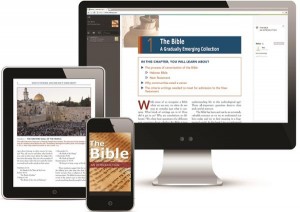 My own stint with an e-textbook startup last year taught me about the complexity of the format. It’s not enough to be a digital copy of a paper book, with perhaps bookmarks and highlighting. There are already plenty of e-readers for that. You need to offer layers of utility and connectivity that could drive a user’s commitment to your platform. (Of course, the user might be a student with no choice, but then it’s the teacher or professor you’re convincing.)
My own stint with an e-textbook startup last year taught me about the complexity of the format. It’s not enough to be a digital copy of a paper book, with perhaps bookmarks and highlighting. There are already plenty of e-readers for that. You need to offer layers of utility and connectivity that could drive a user’s commitment to your platform. (Of course, the user might be a student with no choice, but then it’s the teacher or professor you’re convincing.)
inkling is an established platform — they date back to 2009, which is ancient in this field and predates the iPad, just. It’s used for business, consumer and academic titles. I perused one of four new religion titles on the platform from Fortress Press: The Bible: An Introduction. It’s a textbook, but will be of interest to both students and general interest readers. I used inkling on both my iPad running iOS 5 and iPhone running iOS 7. (I will write about another title in the series, Introduction to the History of Christianity, later.)
In addition to the navigation and search features common to all ebooks, e-textbooks improve on their paper counterparts in two main areas. They add “richness” to the content, such as embedded multimedia and browser links to expand on what is contained in the print version, or to better explore what is already there (such as large-scale pannable versions of maps and other images), and pop-ups for footnotes, endnotes, definitions and citations. For the non-student and student alike, these tools ease taking on complex material. You can get an explanation of a term instantly, or follow a link in a citation or “more info” box for an in-depth explanation of something, then return to the text where you left off. E-textbooks also add study aids, such as self-assessment quizzes at the ends of chapters, and even social tools that allow students in a class to communicate with each other and with the professor, sharing notes and asking questions. These I did not explore, though I know many professors believe they improve the learning experience in their classrooms.
Navigation is a strong point for inkling. You can tell this platform is relatively mature, and built for devices rather than being a lowest common denominator solution built off of a browser version. I was able to use swiping intuitively much of the time (though now, when a left or up swipe doesn’t return or close, it feels like such a chore to have to click on the back button. LOL!) And the ordered structure — with table of contents always a swipe away to jump sections — never failed to make sense, which is more than I can say for most ebook navigation systems.
Overall, The Bible: An Introduction is a great introduction to the Bible (fulfilling its mission as defined by its title). It walks you through the history of how the present day Bible developed, and the processes and challenges of translation, before diving into a section by section walk through the text. This textbook has a single author, Jerry L. Sumney (though a team of experts helped develop the enhanced digital version), and it has a clear conversational tone. The author’s prose is engaging and a non-academic reader will have no problem tackling the material. Each chapter takes on a section of the Bible — the prophets, the Psalms, the Wisdom literature, the Gospels, etc. — and offers lots of help in understanding the intended purpose of its content, its socio-historical context, translation and authenticity issues, and some thoughts about what it’s saying. It’s a quick and solid grounding that will help you in reading the Bible and in going deeper into its meaning.
One small content complaint is related to the author’s voice: In attacking inerrancy, Sumney brings up the issue again and again — pointing out historical errors in scripture, inconsistencies between books, etc. It’s not that I don’t agree with him. It just seems to me that anyone who is committed to inerrancy will not be reading this textbook anyway, and those friendly to the idea don’t need the repeated examples. It felt a bit much.
One small e-textbook complaint: most of the scripture references in The Bible: An Introduction not only aren’t accompanied by the scripture text; they aren’t even linked. I found myself needing to use the inkling book on my iPad side-by-side with my Olive Tree bible app on my phone, which was clumsy and rather defeated the convenience argument for digital book. I understand that to include the text from a current translation may not have been possible, with the rights and costs, but several references are linked to the passage in biblegateway.com, so why not do that from them all?
All in all, I found it a pleasure to read The Bible: An Introduction. While I already had a fairly good grounding in the material, I learned some things and enjoyed Sumney’s perspective. If you lack a grounding in the Bible, The Bible: An Introduction would be a very readable and helpful starting point. And I especially enjoyed reading it as an inkling e-textbook. The logical organization, the extensive use of gestures for navigation, and the ability to follow links for quick explanations and extended looks at subjects, then jump right back into the text where I left off, all make the learning experience easier, quicker and more enjoyable.
The Bible: An Introduction is a selection of the Patheos Book Club. For other posts about the book, samples, more information or to join the conversation, click here.












